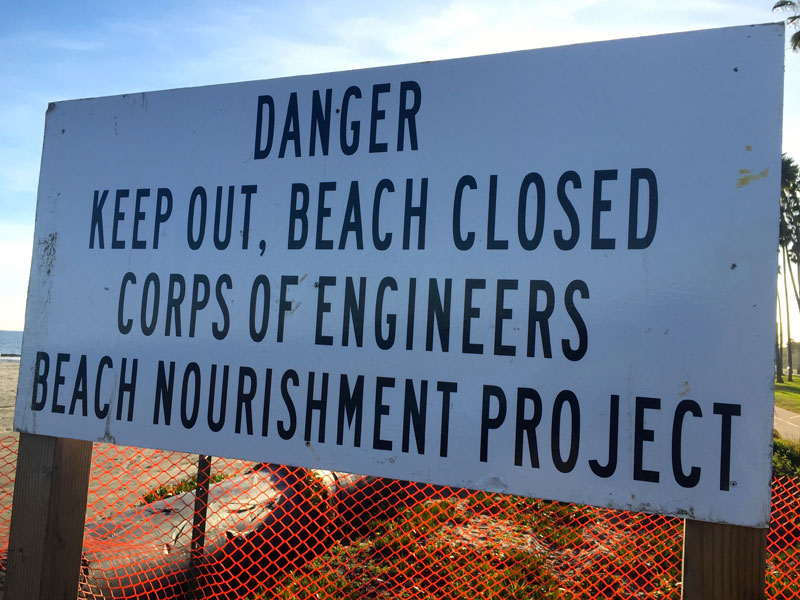Photograph: © SAF — Coastal Care
Excerpts;
Beach managers import sand and constantly groom shores with heavy machinery, and a recent study in the journal Ecological Indicators shows these managed beaches have much fewer sand-dwelling critters than nearby natural ones.
You may not even realize how much life is hiding there in plain sight…
Also of Interest:
Beach replenishment may have far reaching impacts on ecosystems;” Phys.Org (03-29-2016)
UC San Diego biologists who examined the biological impact of replenishing eroded beaches with offshore sand found that such beach replenishment efforts could have long-term negative impacts on coastal ecosystems…
Can Adding Sand to Beaches Save Them? How Stuff Works (04-13-2018)
The question is, can beach nourishment keep up with the ever-increasing forces of climate change or, like Sisyphus forever pushing his boulder up the hill, is adding sand to beaches an expensive, temporary fix to a long-term problem?..
A look at the billions of dollars behind beach renourishment: Is it worth it? WMBF (10-15-2018)
“A Never-Ending Commitment”: The High Cost of Preserving Vulnerable Beaches; ProPublica (09-27-2018)
The U.S. government pays to dump truckloads of sand onto eroding beaches, in a cycle that is said to harm ecosystems and disproportionately benefit the rich…
Coastal geologist criticizes beach renourishment efforts; By Robert S. Young, PhD; The State (08-17-2016)
Rob Young, who heads the Program for the Study of Developed Shorelines at Western Carolina University, said the government is subsidizing coastal development with renourishment money – and that’s costing taxpayers. Communities across the country have spent millions of dollars renourishing beaches. Those efforts encourage people to rebuild after every major hurricane…
Palm Beach Mid-Town Dredge Project, A Youtube Video (02-04-2015)
“Beach nourishment projects like this have become commonplace along the US East and Gulf Coasts. These projects have immediate environmental impacts through burial of nearshore habitat and increased turbidity during project placement.The cumulative environmental impacts of doing this repeatedly on the same beach while conducting projects from Maine to Texas is unknown. But, we should be concerned. ” —Robert S. Young, PhD, Director, Program for the Study of Developed Shorelines, Professor, Coastal Geology, Western Carolina University
Piling sand to stop erosion ultimately made the land sink, study says, NOLA (12-26-2015)
Is pumping more sand onto NC beaches causing deadly currents?; The News & Observer (08-30-2018)
A growing number of scientists and coastal engineers worry that there’s a serious downside to beach nourishment: Unnaturally altered beaches could pose an elevated risk of injury to the very tourists that sand replenishment was meant to attract…
A wider, deeper beach awaits Ocean City vacationers, but is it safe? The Washington Post (06-01-2018)
Ocean City vacationers may notice deeper, wider beaches, the result of a $282 million sand-dredging project aimed at protecting the resort town from storm damage. But the work also raises concerns about surf injuries and swimmer safety…
Widening beaches might bring more hazards, researchers say; Sun Sentinel (04-04-2018)
Widening beaches might be linked to an increase in accidents, according to new data. The number of ocean rescues spikes after beaches are buffed up, according to the data published in the Journal of Ocean Research…
A Feast Interrupted; By Hal Hughes, in Making Waves (06-04-2010)
Every few days, in some places as often as twice a day, tractors roll along a hundred miles or so of sandy beaches in southern California, scooping up not only trash but also seaweed that’s washed ashore, along with the myriad small creatures that shelter in it. This mechanical “beach grooming”, practiced for decades, helps keep up the classic sand-and-surf image that draws millions of people to the region’s beaches, but it also sweeps away a resource that provides vital nourishment for shorebirds…









